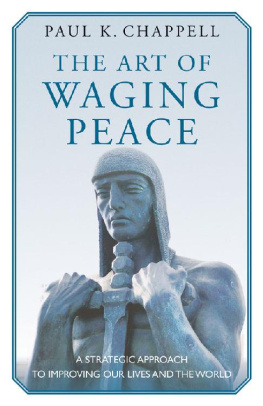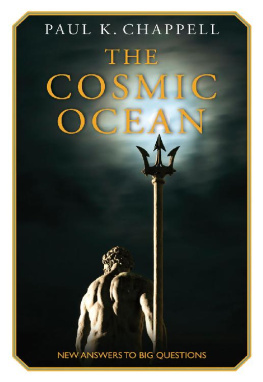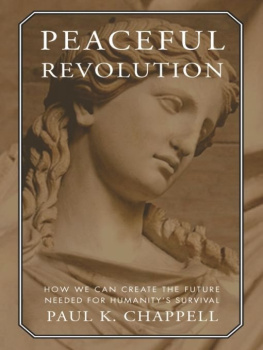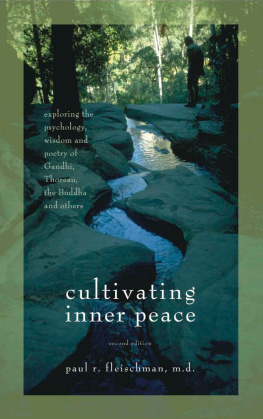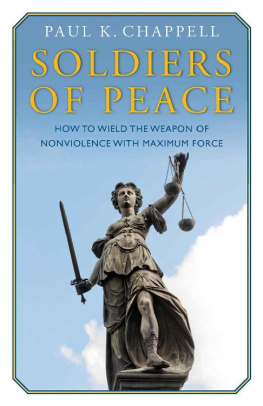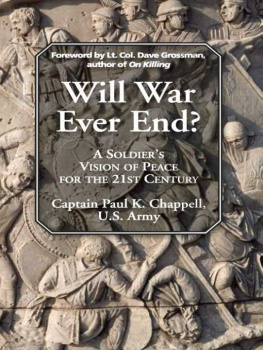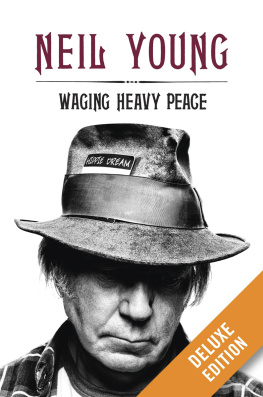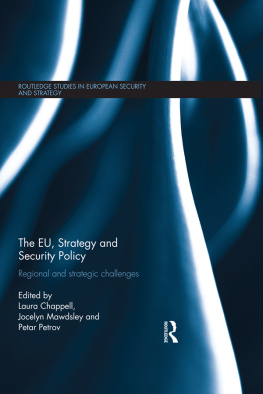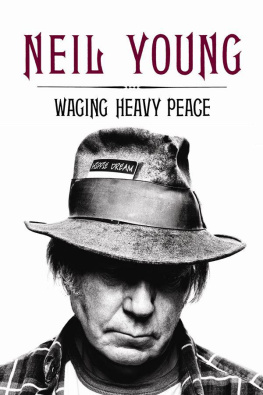Paul K. Chappell - The Art of Waging Peace: A Strategic Approach to Improving Our Lives and the World
Here you can read online Paul K. Chappell - The Art of Waging Peace: A Strategic Approach to Improving Our Lives and the World full text of the book (entire story) in english for free. Download pdf and epub, get meaning, cover and reviews about this ebook. year: 2013, publisher: Easton Studio Press, LLC, genre: Politics. Description of the work, (preface) as well as reviews are available. Best literature library LitArk.com created for fans of good reading and offers a wide selection of genres:
Romance novel
Science fiction
Adventure
Detective
Science
History
Home and family
Prose
Art
Politics
Computer
Non-fiction
Religion
Business
Children
Humor
Choose a favorite category and find really read worthwhile books. Enjoy immersion in the world of imagination, feel the emotions of the characters or learn something new for yourself, make an fascinating discovery.
- Book:The Art of Waging Peace: A Strategic Approach to Improving Our Lives and the World
- Author:
- Publisher:Easton Studio Press, LLC
- Genre:
- Year:2013
- Rating:5 / 5
- Favourites:Add to favourites
- Your mark:
- 100
- 1
- 2
- 3
- 4
- 5
The Art of Waging Peace: A Strategic Approach to Improving Our Lives and the World: summary, description and annotation
We offer to read an annotation, description, summary or preface (depends on what the author of the book "The Art of Waging Peace: A Strategic Approach to Improving Our Lives and the World" wrote himself). If you haven't found the necessary information about the book — write in the comments, we will try to find it.
The Art of Waging Peace: A Strategic Approach to Improving Our Lives and the World — read online for free the complete book (whole text) full work
Below is the text of the book, divided by pages. System saving the place of the last page read, allows you to conveniently read the book "The Art of Waging Peace: A Strategic Approach to Improving Our Lives and the World" online for free, without having to search again every time where you left off. Put a bookmark, and you can go to the page where you finished reading at any time.
Font size:
Interval:
Bookmark:


For Jo Ann Deck,
goddess of compassion and strategic mastermind
G ENERAL D OUGLAS M AC A RTHUR
S PEAKING ON THE N EED TO A BOLISH W AR
The leaders are the laggards. The disease of power seems to confuse and befuddle them... They debate and turmoil over a hundred issuesthey bring us to the verge of despair or raise our hopes to utopian heights over the corollary misunderstandings that stem from the threat of warbut never in the chancelleries of the world or the halls of the United Nations is the real problem raised. Never do they dare to state the bald truth, that the next great advance in the evolution of civilization cannot take place until war is abolished...
I am sure that every pundit in the world, every cynic and hypocrite, every paid brain washer, every egotist, every troublemaker, and many others of entirely different mold, will tell you with mockery and ridicule that [the abolition of war] can be only a dreamthat it is but the vague imaginings of a visionary. But, as David Lloyd George once said in Commons at the crisis of the First World War, We must go on or we will go under. And the great criticism we can make of the worlds leaders is their lack of a plan which will enable us to go on. All they propose merely gravitates around but dares not face the real problem. They increase preparedness [for war] by alliances, by distributing resources throughout the world, by feverish activity in developing new and deadlier weapons... We are told that this increases the chances of peacewhich is doubtfuland increases the chances of victory if war comeswhich would be incontestable if the other side did not increase in like proportion. Actually, the truth is that the relative strengths of the two change little with the years. Action by one is promptly matched by reaction from the other...
I recall so vividly this problem when it faced the Japanese in their new Constitution. They are realists; and they are the only ones that know by dread experience the fearful effect of mass annihilation. They realize in their limited geographical area, caught up as a sort of no mans land between two great ideologies, that to engage in another war, whether on the winning or the losing side, would spell the probable doom of their race. And their wise old Prime Minister, Shidehara, came to me and urged that to save themselves they should abolish war as an international instrument. When I agreed, he turned to me and said, The world will laugh and mock us as impractical visionaries, but a hundred years from now we will be called prophets.
Sooner or later the world, if it is to survive, must reach this decision. The only question is, When? Must we fight again before we learn? When will some great figure in power have sufficient imagination and moral courage to translate this universal wishwhich is rapidly becoming a universal necessityinto actuality? We are in a new era. The old methods and solutions no longer suffice. We must have new thoughts, new ideas, new concepts, just as did our venerated forefathers when they faced a new world. We must break out of the straitjacket of the past. There must always be one to lead, and we should be that one. We should now proclaim our readiness to abolish war in concert with the great powers of the world. The result would be magical.
T HE T HREE F ORMS OF C HANGE
West Point and the U.S. Army trained me how to be a peace activist. If you think working for world peace means pursuing a naive and impossible dream, what I learned in the military may change your mind, just as it transformed my understanding of humanitys potential for peace. To explain my transformation, this book will shatter commonly held stereotypes about soldiers and peace activists. These stereotypes not only deceive and divide us, but they also prevent us from understanding the art of waging peace and the power it gives us to solve our national and global problems. Before I can explain what waging peace is and how I learned the deepest secrets of this art while serving in the military, I must first tell you an unlikely story. It is the story of who I am, and how I got here.
Waging peace empowers us to create three forms of change. My life embodies these three forms; they are the reason I am able to write these words and work for peace today. The first form, which has affected my life and the lives of countless others, is societal change.
I am a descendant of African slaves, and I grew up in Alabama. Although I was born in 1980, my father taught me to think like someone living before the civil rights movement. During my childhood, my father always told me, The army is the only place in America where black men are given
Half black and half white, my father was born in 1925 and grew up in Virginia during segregation and the Great Depression. The U.S. Army was desegregated in the early 1950s, many years before segregation ended in the South. This made a strong impression on my father. During the 1940s and 1950s, his belief that he only had opportunity in the military was largely true. A hard worker who began picking fruit when he was six years old to earn extra income for his family, he fought in the Korean and Vietnam Wars and retired as a command sergeant major, the highest enlisted rank.
I graduated from West Point in 2002 and served in the army for seven years. My mother is Korean, and when I told her in 2009 that I was leaving active duty, she said: Are you out of your mind? Nobody is going to hire you. Its bad enough you look Asian, but youre also part black. Nobody is going to give a job to a black man who looks Asian. My parents did not tell me lies. On the contrary, they told me their truth. They were describing life as they had experienced it and trying to protect me from the suffering they endured. Although I experienced racism as a child, as an adult I began to realize that my multi-ethnic background was no longer the hindrance my parents believed it to be, and that I owed my very existence to the power of waging peace and its ability to change our society for the better.
Americas Founding Fathers rebelled against Great Britain because they felt unfairly treated. They believed it was unjust to be taxed or controlled without the opportunity to participate in the political process. They also believed that those who govern must gain the consent of the governed. The motto No taxation without representation echoed their outrage and became a call to arms, leading to the American Revolution (17751783). Yet decades after the war ended, less than 10 percent of the American population could vote in national elections. Women could not vote. African Americans could not vote. And most white people could not vote unless
How did so many Americans increase their liberties during the past two hundred years? Did nonlandowners fight a war to obtain the right to vote? Did women fight a war to get the right to vote? Did African Americans fight a war to attain their civil rights? Did American workers fight a war to gain their rights? Was a war fought for child labor laws? These victories for liberty and justice were achieved because people waged peace, but this is a part of our history many people do not remember.
This is not the only part of our history that has been largely forgotten. By exploring the truth of our human history, in addition to the history of our country, we can understand how far humanity has come, how much further we can go, and how we can get there.
Next pageFont size:
Interval:
Bookmark:
Similar books «The Art of Waging Peace: A Strategic Approach to Improving Our Lives and the World»
Look at similar books to The Art of Waging Peace: A Strategic Approach to Improving Our Lives and the World. We have selected literature similar in name and meaning in the hope of providing readers with more options to find new, interesting, not yet read works.
Discussion, reviews of the book The Art of Waging Peace: A Strategic Approach to Improving Our Lives and the World and just readers' own opinions. Leave your comments, write what you think about the work, its meaning or the main characters. Specify what exactly you liked and what you didn't like, and why you think so.

